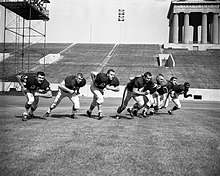Mike Pyle (American football)
| Date of birth | July 18, 1939 |
|---|---|
| Place of birth | Center |
| US college | Yale |
| High school | New Trier (Winnetka, Illinois) |
| NFL draft | 1961 / Round: 7 / Pick: 89 |
| Career history | |
| As player | |
| 1961–1969 | Chicago Bears |
| Career highlights and awards | |
| |
| Pro Bowls | 1 |
| Career stats | |
| |
Michael Johnson Pyle (July 18, 1939 – July 29, 2015) was an American professional
Background
Pyle was born in 1939 to William Palmer Pyle, an executive with
Pyle attended
He graduated in 1957 from New Trier and went on to
Chicago Bears

Pyle played nine seasons with the Chicago Bears from
Broadcast career
After his retirement in 1969, Pyle was a broadcaster for WGN radio, where he was the Bears pre and post game program host, as well as the host of a Sunday sports talk show. He later co-hosted the "Mike Ditka Show" when Ditka coached the Bears.
In 1974, he served as color commentator on the broadcasts of the WFL's Chicago Fire on WJJD.[3]
Post career health problems
Several years after retiring from the NFL, Pyle began to experience symptoms of dementia. His condition eventually worsened, and his family was forced to put him into a full-time assisted living facility. Pyle went to Silverado, a national chain that has an arrangement with the NFL to treat all former players with at least three years of service — and dementia — free of charge.
‘‘We have treated about 20 NFL players — we have about a dozen right now,’’ Loren Shook, the president and CEO of Silverado Senior Living, says. ‘‘This is under the ‘88 Plan’ with the NFL.’’
The 88 Plan is a brain trauma program named for Hall of Fame tight end John Mackey, whose number was 88. Mackey was in a near vegetative state from chronic traumatic encephalopathy (CTE) by the time he died in 2011.[4] Pyle died on July 29, 2015, from a brain hemorrhage.[5][6] He is one of at least 345 NFL players to be diagnosed after death (CTE) with this disease, which is caused by repeated hits to the head.[7][8]
References
- ^ "The Oddest Tidbit of the 2019 Draft". Sports Illustrated. Retrieved 2023-09-21.
- ^ "College Football Poll, Past Football Rankings 1960's". www.collegefootballpoll.com. Archived from the original on 30 June 2007. Retrieved 13 January 2022.
- ^ radio broadcast of WFL game Philadelphia Bell vs. Chicago Fire; August 14, 1974; WJJD
- ^ "Ex-Bear Mike Pyle Another NFL Great Sadly Slipping Away from Dementia - Silverado". Archived from the original on 2014-03-24. Retrieved 2014-03-24.
- ^ Goldstein, Richard (31 July 2015). "Mike Pyle, Captain of 9-0 Yale Team and Champion Bears in '63, Dies at 76". The New York Times.
- ^ "Former Bears center Mike Pyle dead at 76 | Chicago". Archived from the original on 2015-08-03. Retrieved 2015-08-08.
- ^ "The driving force behind Chronic Traumatic Encephalopathy (CTE)". Concussion Legacy Foundation. Retrieved July 2, 2023.
- ^ Ken Belson and Benjamin Mueller (June 20, 2023). "Collective Force of Head Hits, Not Just the Number of Them, Increases Odds of C.T.E. The largest study of chronic traumatic encephalopathy to date found that the cumulative force of head hits absorbed by players in their careers is the best predictor of future brain disease". The New York Times. Retrieved July 2, 2023.
